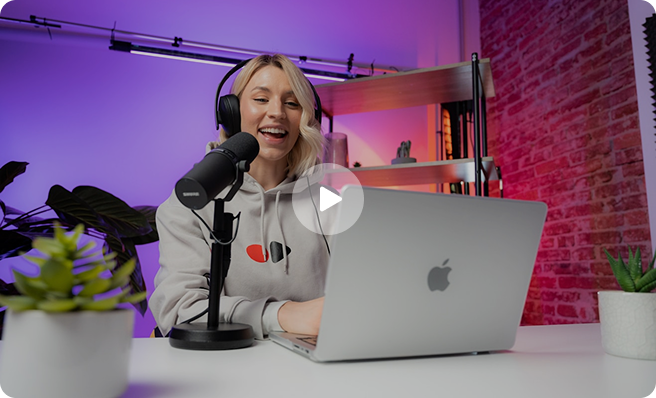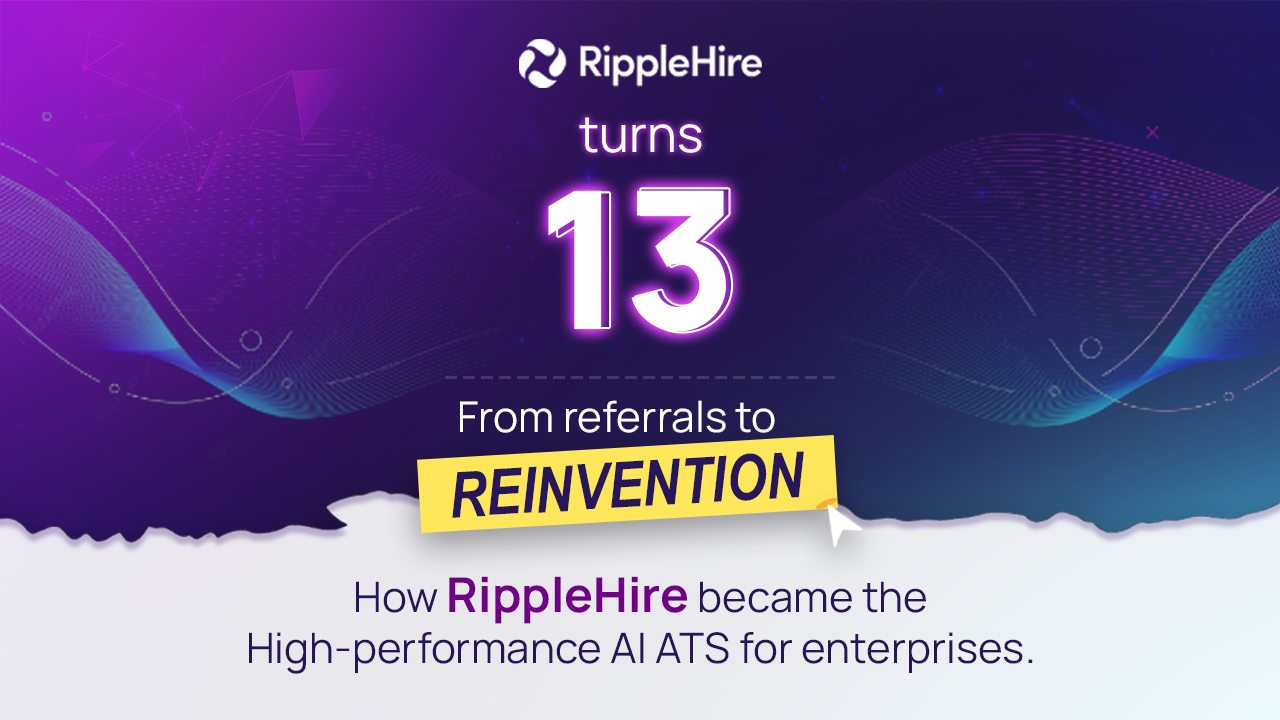How to shortlist candidates faster in walk-in recruitment
Walk-in drives are a popular way to hire for high-volume roles like sales executives, insurance agents, or customer support staff. But anyone who has managed one knows how quickly they can spiral out of control.
Dozens—or sometimes hundreds—of candidates turn up, resumes pile up, interviewers get overwhelmed, and shortlisting the right people becomes a guessing game.
The result is long delays, frustrated candidates, and missed hiring targets. This blog will show you how to cut through that chaos, speed up shortlisting, and still ensure you walk away with the right talent for the job.
Step 1: Lock your shortlist criteria before the walk-in
One of the biggest reasons walk-ins drag is unclear criteria. When every recruiter or interviewer interprets “qualified” differently, you end up screening on the spot and wasting hours. A little preparation avoids this chaos.
Start by separating essentials from extras:
- Must-haves: local language fluency, willingness to travel, shift flexibility.
- Good-to-haves: prior industry experience, strong sales pitch, tenure in past jobs.
Convert these into a short scorecard. For example:
- Knockout rules: work eligibility, compensation fit, education baseline.
- Weighted factors: communication (40%), relevant experience (25%), job stability (15%), flexibility (10%), location proximity (10%).
When candidates pre-register through a simple form, the system can score them automatically and flag obvious mismatches or duplicates. Tools like RippleHire’s AI ATS even apply fraud detection and auto-tagging.
When you walk into the venue with criteria locked and auto-scoring configured, the conversation shifts. Recruiters spend energy with promising candidates instead of screening at the gate, and interviewers receive a queue of candidates who are already pre-qualified. The result is sharper decisions, faster hiring, and less burnout on the ground.
Step 2: Design the drive-day flow to surface high-fit profiles first
Even with strong criteria, the day itself can break down without structure. Long queues, misplaced forms, and idle panels cost you speed. Think of your drive as a flow that channels the right people to the right place.
At entry, a simple triage works wonders:
- Green lane: pre-scored, high-fit candidates → go straight to interview panels.
- Yellow lane: borderline profiles → short screening round first.
- Help desk: missing documents, queries, or incomplete forms.
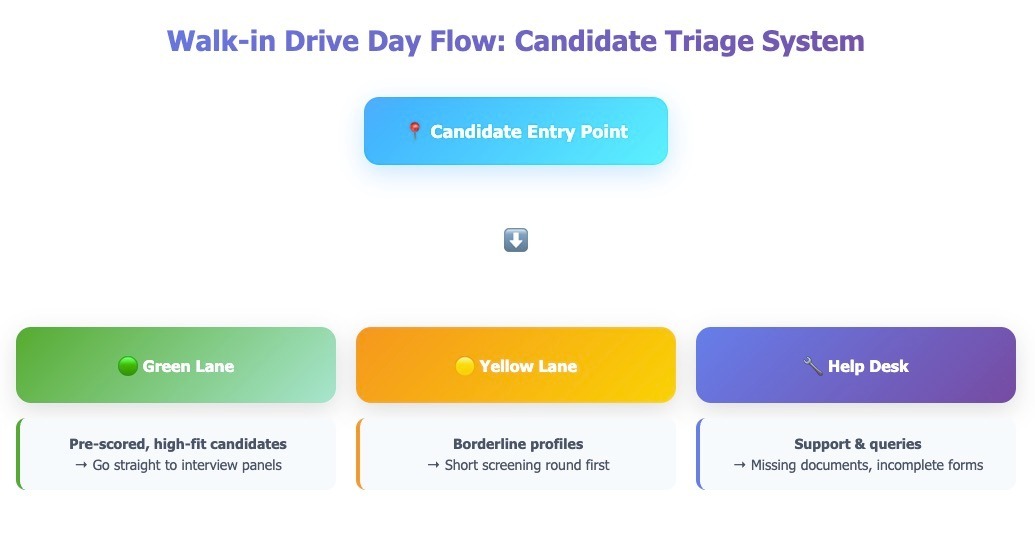
Inside, keep the process light but revealing. A 10-minute role play (sales pitch, service response, or insurance consult) quickly validates the resume. Meanwhile, digital scheduling ensures candidates are auto-assigned to interviewers without manual coordination.
Small details accelerate things further:
- Time-slot SMS to avoid crowding.
- Live dashboards showing panel load.
- Feedback captured in-system with mandatory ratings, not scribbled notes.
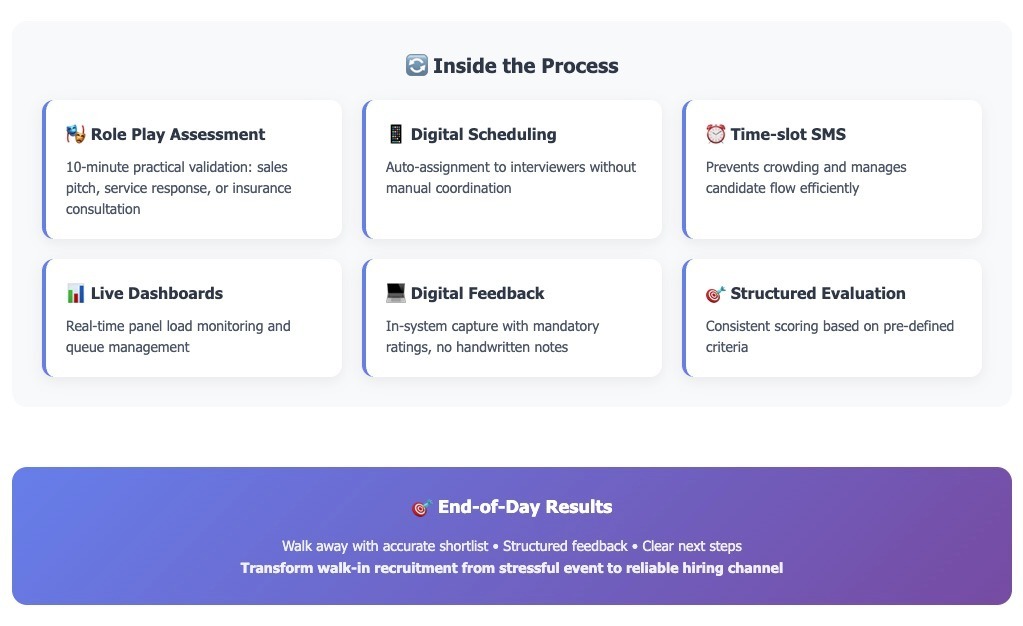
By the end of the day, you leave with an accurate shortlist, structured feedback, and clear next steps — instead of a pile of forms that need days of cleanup. That speed is what turns walk-in recruitment from a stressful event into a reliable hiring channel.
Step 3: Keep interviewers aligned and accountable
A walk-in drive moves only as fast as its slowest panel. If interviewers are unclear on what to assess or delay feedback, the entire shortlist suffers. The key is to set expectations up front and make accountability easy.
Start with alignment before the drive:
- Share the shortlist criteria and scorecard so every interviewer knows what matters most.
- Walk them through sample candidate profiles — this reduces inconsistent evaluations on the day.
- Define turnaround expectations clearly: feedback to be submitted immediately after each interaction.
During the drive, structure helps. Instead of handing out random resumes, assign candidates automatically based on panel load. This ensures no panel sits idle while another drowns in a queue.
Feedback must be captured digitally, not on paper or memory.
A structured form with a few rating scales (e.g., communication, motivation, stability) and a mandatory decision code (move forward, reject, review) keeps everyone disciplined. RippleHire’s interviewer management feature does exactly this — interviewers can log feedback in minutes on their phone or laptop, and recruiters see real-time progress.
This alignment reduces disputes, fast feedback keeps the pipeline moving, and accountability means you end the day with a shortlist ready for next steps. No chasing interviewers for notes, no debating what “good” looked like — just consistent, data-backed decisions.
Step 4: Close the loop quickly with the shortlisted candidates
Shortlisting is only half the battle. If you wait days to communicate outcomes, the best candidates may vanish — especially in high-volume roles where multiple offers are common. Speed of follow-up is what keeps your walk-in efforts from leaking talent.
The process works best when outcomes are captured and shared before candidates leave the venue. Even a simple “You’re shortlisted, expect your offer process within 48 hours” builds trust and reduces drop-offs. Delays, on the other hand, create space for competitors to step in.
Practical ways to close the loop:
- Use instant SMS/WhatsApp updates to confirm next steps.
- Share timelines for offer rollout and joining clearly, so expectations are managed.
- For rejections, send polite closure messages the same day — it protects your brand and reduces repeat queries.
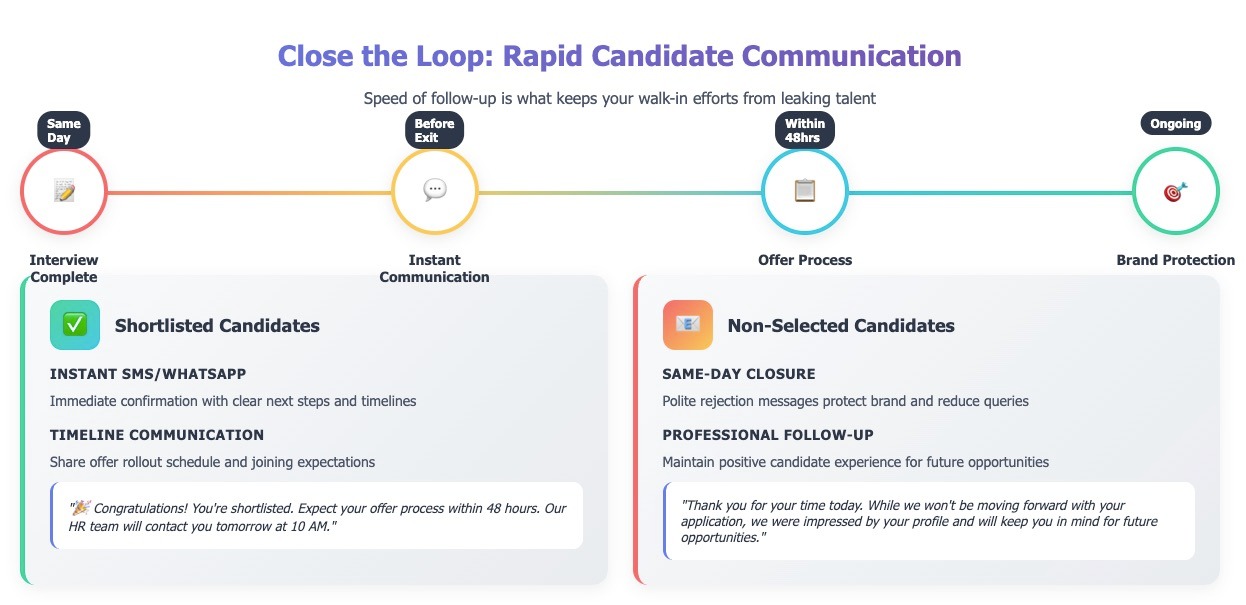
RippleHire’s ATS makes this seamless by linking interview feedback, recruiter approvals, and communication templates. Once a candidate is marked “move ahead,” the system can trigger automated updates while ensuring compliance and audit trails.
The real benefit is that you don’t just finish a walk-in with names on a spreadsheet.
You walk out having moved shortlisted candidates forward, closed rejections, and protected your employer brand. That speed is often the difference between hitting your hiring targets and running another walk-in to fill the same roles.
Step 5: Track signals after the drive to reduce drop-offs
A walk-in doesn’t end when candidates walk out the door. Many organizations lose time and money because shortlisted candidates disengage, delay document submission, or back out before joining. Tracking post-drive signals helps you spot these risks early.
Look for patterns in candidate behavior:
- Delayed responses to calls or emails.
- Hesitation around joining dates or compensation.
- Incomplete documentation, even after reminders.
These small signs often indicate a candidate is juggling multiple offers or isn’t fully committed. By setting up short check-ins — whether a quick call, a friendly message, or a progress update — you can re-engage them and answer concerns before they escalate.
Another effective step is to keep communication structured and predictable. Share timelines, onboarding schedules, and role expectations clearly. Candidates who know exactly what’s coming are less likely to drift away.
This way, instead of losing shortlisted talent silently, you proactively manage risks and maintain a healthier pipeline. It also reassures hiring managers that the walk-in wasn’t just about filling interview rooms, but about securing reliable hires who are more likely to show up on day one
Speed up walk-in hiring with RippleHire
Managing a walk-in drive doesn’t have to feel like controlled chaos. With RippleHire, you can bring structure and intelligence to every stage of the process.
- Our AI-powered ATS helps you screen and shortlist candidates instantly, so your recruiters spend time with the right profiles instead of shuffling through resumes.
- Drive automation makes it easy to manage candidate flow, schedule interviews, and assign interviewers without manual follow-ups.
- Built-in fraud detection and compliance features protect your hiring process, while interviewer management ensures timely feedback and faster decisions.
You'll close roles quickly, give every candidate a professional experience, and free up recruiter bandwidth for strategic work. If walk-in recruitment is a key part of your hiring mix, RippleHire can help you run it at scale. Book a demo today and see how.
FAQs: How to Shortlist Candidates Faster in Walk-in Recruitment
1. How do I prepare for a walk-in recruitment drive to avoid chaos?
Start by locking in your shortlist criteria. Define must-haves like language fluency or shift flexibility, and separate them from nice-to-haves. Creating a clear scorecard prevents recruiters from screening blindly at the venue. This preparation ensures that interviewers focus on the right candidates instead of wasting time at the gate.
2. What should be included in the shortlist criteria for walk-in hiring?
Keep it simple but structured. Use knockout rules such as work eligibility or education, then assign weights to factors like communication skills, experience, or job stability. This way, recruiters rely on objective scoring rather than gut feel. Many companies also use pre-registration forms to capture and score candidates before the walk-in.
3. How do I structure the flow of candidates during a walk-in drive?
Think of your drive like a channel with lanes. High-fit candidates should move directly to interviews, while borderline profiles go through a quick screening. A help desk can manage incomplete applications or queries. Adding role plays, live dashboards, and digital scheduling keeps the flow smooth and avoids bottlenecks.
4. Why is interviewer alignment critical in walk-in recruitment?
A drive is only as fast as its slowest panel. Misaligned interviewers or delayed feedback can derail the whole process. Share scorecards in advance, set clear expectations for real-time feedback, and capture evaluations digitally. This consistency avoids disputes and ensures a ready shortlist at the end of the day.
5. How quickly should outcomes be shared with candidates after a walk-in?
The sooner, the better. Ideally, outcomes should be communicated before candidates leave the venue. Even a simple SMS confirming “shortlisted” or “not moving forward” builds trust and protects your brand. Delayed communication often leads to drop-offs, as high-volume candidates usually juggle multiple offers.
6. What are the best ways to reduce drop-offs after a walk-in drive?
Track post-drive signals like delayed responses, hesitation around joining, or incomplete documentation. These are early warnings that a candidate may back out. Regular check-ins, clear onboarding timelines, and transparent communication keep candidates engaged and reduce last-minute surprises.
7. How can RippleHire help speed up shortlisting in walk-in recruitment?
RippleHire’s AI-powered ATS automates scoring, candidate flow, and interviewer assignments. Recruiters spend time on promising candidates, interviewers log instant feedback, and candidates get real-time updates. With fraud detection and compliance built in, RippleHire transforms walk-ins into structured, scalable, and stress-free hiring events.



